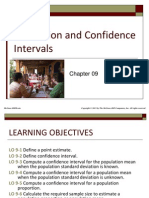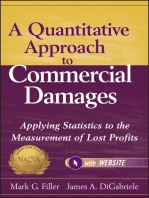0 ratings0% found this document useful (0 votes)
54 viewsChapter 9
Uploaded by
Saurabh Prakash GiriCopyright
© © All Rights Reserved
Available Formats
Download as PPT, PDF, TXT or read online on Scribd
0 ratings0% found this document useful (0 votes)
54 viewsChapter 9
Uploaded by
Saurabh Prakash GiriCopyright
© © All Rights Reserved
Available Formats
Download as PPT, PDF, TXT or read online on Scribd
You are on page 1/ 23
Copyright© Dorling Kindersley India Pvt Ltd
Chapter 9
Statistical Inference:
Estimation for Single
Populations
Business Statistics - Naval
Bajpai
Learning Objectives
Copyright© Dorling Kindersley India Pvt Ltd
Upon completion of this chapter, you will be able to:
Understand the concept of estimation and types of estimators
Use z-statistic for estimating population mean
Understand the concept of confidence interval for estimating
population mean μ when σ is unknown
Estimate population mean using the t statistic test (small sample
case)
Understand the concept of confidence interval estimation for
population proportion
Understand the concept of sample size for estimating population
mean μ
Understand the concept of sample size for estimating the population
proportion p
Business Statistics - Naval Bajpai
Statistical Inference
Copyright© Dorling Kindersley India Pvt Ltd
Statistical inference is the branch of statistics which deals
with uncertainty in decision making and provides a basis
for making scientific decisions.
Business Statistics - Naval Bajpai
Types of Estimates
Copyright© Dorling Kindersley India Pvt Ltd
We can make two types of estimates about the population.
They are referred to as point estimates and interval
estimates.
A point estimate is the sample statistic that is used to
estimate the population parameter.
An interval estimate is the range of values within which a
researcher or an employee can say with some confidence
that the population parameter falls. This range is called
confidence interval.
Business Statistics - Naval Bajpai
Using the Z Statistic for Estimating Population
Copyright© Dorling Kindersley India Pvt Ltd
Mean
The z statistic can be used for estimating the population
parameter on the basis of the sample statistic.
Confidence interval for estimating population mean μ
The confidence interval with the associated probability can be
calculated as below:
Business Statistics - Naval Bajpai
Copyright© Dorling Kindersley India Pvt Ltd
Figure 9.1: z scores for confidence interval in relation to
alpha
In estimation, any confidence level can be applied; however,
the most widely used levels are 90 %, 95%, and 99%.
Business Statistics - Naval Bajpai
Copyright© Dorling Kindersley India Pvt Ltd
Figure 9.2: Distribution of sample means for 99% confidence
interval
Business Statistics - Naval Bajpai
Business Statistics - Naval Bajpai
Copyright© Dorling Kindersley India Pvt Ltd
Copyright© Dorling Kindersley India Pvt Ltd
Example 9.1: A researcher has taken a random sample of size 70 from
a population with a sample mean of 35 and a population standard
deviation of 4.62. Construct a 90% confidence interval to estimate the
population mean.
This result implies that the researcher is 90% confident that the
population mean will lie between 34.091 and 35.909. The point
estimate is 35.
Business Statistics - Naval Bajpai
Using MS Excel and Minitab for Confidence
Copyright© Dorling Kindersley India Pvt Ltd
Interval Construction
Solved Examples\Excel\Ex 9.1.xls
Solved Examples\Minitab\Ex 9.1.MPJ
When the sample size is less than 5% of the population, the
finite correction factor does not significantly increase the
accuracy of the solution.
Business Statistics - Naval Bajpai
Confidence interval for estimating population mean μ,
when σ is unknown and sample size is large (n ≥30)
Copyright© Dorling Kindersley India Pvt Ltd
Example 9.3: In order to estimate the customer loyalty for
a particular product, a researcher poses the following
question to a sample of 100 customers: How many years
have you been continuously using this product? This
sample yielded a mean period of 8 years with a sample
standard deviation of 2 years. Construct a 95% confidence
interval for estimating the population mean.
Business Statistics - Naval Bajpai
Example 9.3 (Solution)
Copyright© Dorling Kindersley India Pvt Ltd
This result implies that the researcher is 95% confident that the
population mean (average years after purchase in the
population) will lie between 7.608 years and 8.392 years.
Solved Examples\Excel\Ex 9.3.xls
Solved Examples\Minitab\Ex 9.3.MPJ
Business Statistics - Naval Bajpai
Estimating Population Mean Using the t
Copyright© Dorling Kindersley India Pvt Ltd
Statistic (Small–Sample Case)
In the case of small sample size (n < 30), the z formula
discussed earlier is not applicable. The problem can be solved by
using the t statistic.
Figure 9.10 : Comparison of standard normal curve with two t
distributions having degrees of freedom 10 and 20, respectively
Business Statistics - Naval Bajpai
The t Distribution
Copyright© Dorling Kindersley India Pvt Ltd
The t distribution, developed by William Gosset is a family
of similar probability distributions with a specific t
distribution depending on a parameter known as the
degrees of freedom.
As sample size n increases, t distribution values tend to
approach standard normal curve.
The difference between tabular values of t and z becomes
negligible as sample size increases.This is a reason why
many researchers use the z distribution for large samples.
Business Statistics - Naval Bajpai
The t Distribution (Contd.)
Copyright© Dorling Kindersley India Pvt Ltd
Figure 9.11 : Comparison of standard normal curve
with two t curves with sample size n = 10 and n = 22
Business Statistics - Naval Bajpai
Degrees of Freedom
Copyright© Dorling Kindersley India Pvt Ltd
The number of degrees of freedom indicates the number of values that are
free to vary in a random sample. The degrees of freedom can be understood
as the number of independent observations for a source of variation minus
the number of independent parameters estimated in computing the
variation.
Confidence interval to estimate population parameter μ, when population
standard deviation σ is unknown and the population is normally distributed.
Business Statistics - Naval Bajpai
Copyright© Dorling Kindersley India Pvt Ltd
Example 9.4: The personnel department of an organization wants to
apply cost-cutting measures for improving efficiency. As the first step,
the personnel department wants to curtail telephone expenses incurred
by employees. For this, personnel department has taken a random
sample of 10 employees and gathered the following data about
telephone expenses (in thousand rupees) in the previous year:10, 12,
24, 23, 11, 14, 15, 34, 16, 23. Construct a 95% confidence interval to
estimate the average telephone expenses of the employees in the
population.
Solution:
Solved Examples\Minitab\Ex 9.4.MPJ
Business Statistics - Naval Bajpai
Confidence Interval Estimation for Population
Copyright© Dorling Kindersley India Pvt Ltd
Proportion
Confidence interval to estimate the population proportion p
Example 9.5: A research company conducted a survey on 300
randomly selected tax payers. It found that out of 300 tax
payers, 180 tax payers have filled the “SARAL” form correctly.
Construct a 95% confidence interval to estimate the percentage
of tax payers who have filled the form correctly in the
population.
Business Statistics - Naval Bajpai
Using Minitab to Construct Confidence Interval
Copyright© Dorling Kindersley India Pvt Ltd
Estimation for Population Proportion
Solved Examples\Minitab\Ex 9.5.MPJ
Business Statistics - Naval Bajpai
Sample Size Estimation
Copyright© Dorling Kindersley India Pvt Ltd
Sample Size for Estimating Population Mean μ
The z formula for sample mean is
Business Statistics - Naval Bajpai
Copyright© Dorling Kindersley India Pvt Ltd
Example 9.6: A population has a standard deviation of 4.2
and sampling error of 2.4.Determine the sample size to
estimate the mean of the population with 95% confidence
level?
Business Statistics - Naval Bajpai
Sample Size for Estimating Population
Copyright© Dorling Kindersley India Pvt Ltd
Proportion p
The z formula for sample proportion is
Business Statistics - Naval Bajpai
Copyright© Dorling Kindersley India Pvt Ltd
Example 9.7: A consumer electronics company wants to
determine the job satisfaction levels of its employees. For this,
they ask a simple question, are you satisfied with your job? It
was estimated before the study that no more than 30% of the
employees would answer yes. What should be the sample size
for this company to estimate population proportion to ensure
95% confidence in result, and to be within 0.04 of the true
population proportion?
Solution : Here, p = 0.3; q = 0.7; E = 0.04
Business Statistics - Naval Bajpai
You might also like
- 20211227233453D4998_Chap009_PPT_Estimation and Confidence IntervalsNo ratings yet20211227233453D4998_Chap009_PPT_Estimation and Confidence Intervals31 pages
- Chapter 9 Estimation From Sampling DataNo ratings yetChapter 9 Estimation From Sampling Data22 pages
- Estimation and Confidence Intervals: Point EstimateNo ratings yetEstimation and Confidence Intervals: Point Estimate26 pages
- Understanding Confidence Interval Estimates For The Population MeanNo ratings yetUnderstanding Confidence Interval Estimates For The Population Mean16 pages
- Estimation of Population Parameters: 1) Estimating The Population MeanNo ratings yetEstimation of Population Parameters: 1) Estimating The Population Mean19 pages
- Chapter 9 Estimation From Sampling DataNo ratings yetChapter 9 Estimation From Sampling Data23 pages
- Module 06 - One Population Parameter Estimation - Topic 4ANo ratings yetModule 06 - One Population Parameter Estimation - Topic 4A59 pages
- Applied Statistics: Confidence IntervalsNo ratings yetApplied Statistics: Confidence Intervals8 pages
- Chapter 7 Confidence Interval and Sample Mean ANo ratings yetChapter 7 Confidence Interval and Sample Mean A37 pages
- Estimation and Confidence Intervals: Mcgraw-Hill/IrwinNo ratings yetEstimation and Confidence Intervals: Mcgraw-Hill/Irwin38 pages
- Ch6- Estimation (6)_1696b509adcc3dc40b3ab8b137f8d15dNo ratings yetCh6- Estimation (6)_1696b509adcc3dc40b3ab8b137f8d15d28 pages
- Chapter 8: Estimating With Confidence: Section 8.3 Estimating A Population MeanNo ratings yetChapter 8: Estimating With Confidence: Section 8.3 Estimating A Population Mean27 pages
- OP5205: BUSINESS STATISTICS (2 Credits) Session 21-24 - Confidence Interval & Hypothesis TestingNo ratings yetOP5205: BUSINESS STATISTICS (2 Credits) Session 21-24 - Confidence Interval & Hypothesis Testing77 pages
- CLO4-PPT1-Estimation and Confidence IntervalsNo ratings yetCLO4-PPT1-Estimation and Confidence Intervals29 pages
- CH 4 - Estimation & Hypothesis One SampleNo ratings yetCH 4 - Estimation & Hypothesis One Sample139 pages
- Estimation and Confidence Intervals: Mcgraw Hill/IrwinNo ratings yetEstimation and Confidence Intervals: Mcgraw Hill/Irwin15 pages
- Chapter 09 3f8c81a4bb6cdfa4cac3c2d01ad75a77No ratings yetChapter 09 3f8c81a4bb6cdfa4cac3c2d01ad75a7724 pages
- Data Science for Decision Makers: Enhance your leadership skills with data science and AI expertiseFrom EverandData Science for Decision Makers: Enhance your leadership skills with data science and AI expertiseNo ratings yet
- A Quantitative Approach to Commercial Damages: Applying Statistics to the Measurement of Lost ProfitsFrom EverandA Quantitative Approach to Commercial Damages: Applying Statistics to the Measurement of Lost ProfitsNo ratings yet
- 6.1 Confidence Intervals For The Mean (Large Samples)No ratings yet6.1 Confidence Intervals For The Mean (Large Samples)30 pages
- Statistical Process Control: Operations Management R. Dan Reid & Nada R. SandersNo ratings yetStatistical Process Control: Operations Management R. Dan Reid & Nada R. Sanders32 pages
- Assignment Test-1 Time: 1 Hour Marks: 20No ratings yetAssignment Test-1 Time: 1 Hour Marks: 202 pages
- Business Analytics - The Science of Data Driven Decision MakingNo ratings yetBusiness Analytics - The Science of Data Driven Decision Making55 pages
- Estimation of The Parameters of The Power Size Biased Chris-Jerry DistributionNo ratings yetEstimation of The Parameters of The Power Size Biased Chris-Jerry Distribution14 pages
- Data Mining: Bob Stine Dept of Statistics, Wharton School University of PennsylvaniaNo ratings yetData Mining: Bob Stine Dept of Statistics, Wharton School University of Pennsylvania21 pages
- Biostatistik: (Uji Statistik Chi Square, Mann Whitney Dan Wilcoxon)No ratings yetBiostatistik: (Uji Statistik Chi Square, Mann Whitney Dan Wilcoxon)8 pages
- FS103 - de Guzman - Isaiah - Final ExaminationNo ratings yetFS103 - de Guzman - Isaiah - Final Examination7 pages
- Support Vector Machines Problem StatementNo ratings yetSupport Vector Machines Problem Statement27 pages
- 67c9d235eca2bdbebab746da_AP Statistics Cheatsheet (2025)No ratings yet67c9d235eca2bdbebab746da_AP Statistics Cheatsheet (2025)2 pages
- Statistics_and_Optimization_Techniques_Detailed_Exam_GuideNo ratings yetStatistics_and_Optimization_Techniques_Detailed_Exam_Guide3 pages
- I PUC MID TERM STATS MODEL QUESTION PAPER[1]No ratings yetI PUC MID TERM STATS MODEL QUESTION PAPER[1]3 pages
- Chi-Square Test of Association: Independence. Testing Procedure: Step-1No ratings yetChi-Square Test of Association: Independence. Testing Procedure: Step-14 pages
- Summative Quiz 4 - Statistical Analytics in Business With Software ApplicationNo ratings yetSummative Quiz 4 - Statistical Analytics in Business With Software Application19 pages
- 20211227233453D4998_Chap009_PPT_Estimation and Confidence Intervals20211227233453D4998_Chap009_PPT_Estimation and Confidence Intervals
- Estimation and Confidence Intervals: Point EstimateEstimation and Confidence Intervals: Point Estimate
- Understanding Confidence Interval Estimates For The Population MeanUnderstanding Confidence Interval Estimates For The Population Mean
- Estimation of Population Parameters: 1) Estimating The Population MeanEstimation of Population Parameters: 1) Estimating The Population Mean
- Module 06 - One Population Parameter Estimation - Topic 4AModule 06 - One Population Parameter Estimation - Topic 4A
- Estimation and Confidence Intervals: Mcgraw-Hill/IrwinEstimation and Confidence Intervals: Mcgraw-Hill/Irwin
- Ch6- Estimation (6)_1696b509adcc3dc40b3ab8b137f8d15dCh6- Estimation (6)_1696b509adcc3dc40b3ab8b137f8d15d
- Chapter 8: Estimating With Confidence: Section 8.3 Estimating A Population MeanChapter 8: Estimating With Confidence: Section 8.3 Estimating A Population Mean
- OP5205: BUSINESS STATISTICS (2 Credits) Session 21-24 - Confidence Interval & Hypothesis TestingOP5205: BUSINESS STATISTICS (2 Credits) Session 21-24 - Confidence Interval & Hypothesis Testing
- Estimation and Confidence Intervals: Mcgraw Hill/IrwinEstimation and Confidence Intervals: Mcgraw Hill/Irwin
- Data Science for Decision Makers: Enhance your leadership skills with data science and AI expertiseFrom EverandData Science for Decision Makers: Enhance your leadership skills with data science and AI expertise
- A Quantitative Approach to Commercial Damages: Applying Statistics to the Measurement of Lost ProfitsFrom EverandA Quantitative Approach to Commercial Damages: Applying Statistics to the Measurement of Lost Profits
- 6.1 Confidence Intervals For The Mean (Large Samples)6.1 Confidence Intervals For The Mean (Large Samples)
- Statistical Process Control: Operations Management R. Dan Reid & Nada R. SandersStatistical Process Control: Operations Management R. Dan Reid & Nada R. Sanders
- Business Analytics - The Science of Data Driven Decision MakingBusiness Analytics - The Science of Data Driven Decision Making
- Estimation of The Parameters of The Power Size Biased Chris-Jerry DistributionEstimation of The Parameters of The Power Size Biased Chris-Jerry Distribution
- Data Mining: Bob Stine Dept of Statistics, Wharton School University of PennsylvaniaData Mining: Bob Stine Dept of Statistics, Wharton School University of Pennsylvania
- Biostatistik: (Uji Statistik Chi Square, Mann Whitney Dan Wilcoxon)Biostatistik: (Uji Statistik Chi Square, Mann Whitney Dan Wilcoxon)
- 67c9d235eca2bdbebab746da_AP Statistics Cheatsheet (2025)67c9d235eca2bdbebab746da_AP Statistics Cheatsheet (2025)
- Statistics_and_Optimization_Techniques_Detailed_Exam_GuideStatistics_and_Optimization_Techniques_Detailed_Exam_Guide
- Chi-Square Test of Association: Independence. Testing Procedure: Step-1Chi-Square Test of Association: Independence. Testing Procedure: Step-1
- Summative Quiz 4 - Statistical Analytics in Business With Software ApplicationSummative Quiz 4 - Statistical Analytics in Business With Software Application

























































































